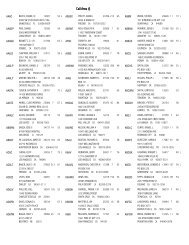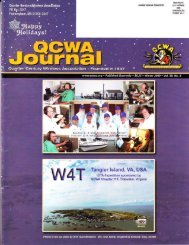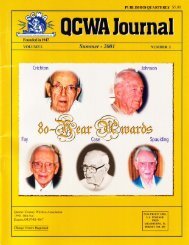ASHLAND, MA PEBMIT NO.7 - Quarter Century Wireless Association
ASHLAND, MA PEBMIT NO.7 - Quarter Century Wireless Association
ASHLAND, MA PEBMIT NO.7 - Quarter Century Wireless Association
You also want an ePaper? Increase the reach of your titles
YUMPU automatically turns print PDFs into web optimized ePapers that Google loves.
the school radio club and earned his amateur<br />
radio license W3EL0 in March, 1934.<br />
He still holds the same radio call sign today.<br />
The CW speed required at that time was<br />
only ten words per minute.<br />
John's teenage years were full of mis-<br />
chief. While playing with his CW key, it<br />
almost electrocuted him, and his father was<br />
furlous because the subsequent relay made<br />
too much noise in the middle of the night,<br />
His rig overwhelmed the electrical power at<br />
his parents' home, and the lights flashed as<br />
he happily carried on transmitting to a ham<br />
in Australia. He built a radio that enabled<br />
him to hear pioneer Pittsburgh Radio Station<br />
KDKA, one of the first radio stations in the<br />
country. At seventeen, John lied about his<br />
age and joined the Maryland National<br />
Guard. He worked diligently through the<br />
ranks and earned a 2nd Lt. commission in<br />
the Field Altillery,<br />
John was accepted to the University of<br />
Maryland in College Park, Maryland, a sub-<br />
urb of Washington, D.C.<br />
While attending classes, John learned to<br />
fly a Piper Cub single-engine, high-wing air-<br />
craft for his private pilot's license and a<br />
Fairchild for an advanced aerobatics course.<br />
ln January, I941 , John s National Guard<br />
unit was called up to active duty. However,<br />
he had only a few months to complete his<br />
degree, so he asked for a waiver from duty.<br />
He graduated in June, 1941 , earning his<br />
Bachelor of Science degree in Electrical<br />
Engineering from the University of Maryland.<br />
The Westinghouse Electric Company<br />
immediately hired him as a microwave tube<br />
division scientist and gave him the job of<br />
building magnetrons and klystrons. He also<br />
helped establish a new Westinghouse plant<br />
in Fairmont, West Virginia.<br />
ln May, 1942, John married Helen Day of<br />
Baltimore. The newlyweds moved to a new<br />
town across the river from Washington,<br />
D.C., known as Fairlington, Virginia. In July<br />
of 1942, John left Westinghouse and Joined<br />
the U.S. Navy. He received a commission as<br />
an Ensign and was assigned to the Navy<br />
Depaftment in Washington, DC. 0nce there,<br />
John joined the Aircraft Radar Design Group<br />
and became paft of a secret project group<br />
charged with developing a guided missile<br />
Quader <strong>Century</strong> Wi reless <strong>Association</strong><br />
with television, which was unknown at that<br />
time.<br />
After six months of workrng on the secret<br />
project, John asked for a transfer to the<br />
South Pacific War Theater for overseas duty,<br />
He received the transfer-to Brisbane,<br />
Australia-to join the 7th Fleet, Service<br />
Force. About this time, Helen returned to<br />
Baltimore, where she gave birth to their first<br />
child in 1943.<br />
John was assigned to Milne Bay, New<br />
Guinea, as the Radio Material 0fficer. This<br />
was a large ship repair facility. He became<br />
the technical troubleshooter on the new, and<br />
in many cases, still secret radar equipment.<br />
As war moved further toward the<br />
Philippines, John earned promotion to Lt<br />
Junior grade. He became the Staff Radar<br />
Officer Commander Aircraft 7th Fleet, which<br />
had no aircraft caniers.<br />
When General MacAfthur landed in the<br />
Philippines, John was on board a seaplane<br />
tender that took parl at Leyte and Lingayan<br />
Gulf operations and eventually Manila Bay in<br />
the Philippines. John learned about the<br />
Navy's plans to train 50,000 men as pilots<br />
for the invasion of Japan. He applied for and<br />
was granted yet another change in duty to<br />
Dallas and Corpus Christi, Texas, for training<br />
on the Stearman and the AT6 aircraft. John<br />
was just graduating from naval flight training<br />
when the war ended in 1945.<br />
John returned to Westinghouse in<br />
Baltimore at their special Air Arm Division.<br />
He became the Manager-Fighter Radar<br />
Engineering, where for six years he was<br />
responsible for the design, development,<br />
and production engineering of a series of<br />
successful high-power, fire-control, radar<br />
systems. For several years, John was also<br />
the industry member of the Department of<br />
Defense, Research, and Development Board,<br />
Airborne Radar and Guidance Equipment<br />
Subpanel.<br />
Some of the electronic systems John<br />
developed are still used today and consid-<br />
ered state-of{he-art. ln 1 948, John earned<br />
the Master of Science degree in Electrical<br />
Engineering from Johns Hopkins University.<br />
ln 1952, John left Westinghouse and<br />
became the President and General Manager<br />
of California Technical lndustries, which had<br />
been formerly known as Color Television,<br />
lnc. He pioneered CTI in automatic electron-<br />
ic test equipment, three-axis flight simula-<br />
tors, and microwave boresighting equip-<br />
ment. CTI eventually became a division of<br />
Textron, lnc., with John President of the divi-<br />
sion.<br />
ln 1961 , John formed Carco Electronics in<br />
Menio Park, California, a few miles from his<br />
home in Athefton. The new company would<br />
design and build flight motion simulators for<br />
the development of guidance and control of<br />
weapons. John donated 1 4 United States<br />
patents to Carco, which flourished as cus-<br />
tomers from all over the world, including<br />
England, France, Germany, Japan, South<br />
Korea, Spain, Australia, Sweden, and<br />
Taiwan, purchased John's products. The<br />
U.S, Government was a big customer, with<br />
large facilities using his products in China<br />
Lake and Point Magu for the Navy; in<br />
Huntsville, Alabama, for the Army; and at<br />
Eglin Air Force Base in Florida for the Air<br />
Force.<br />
John served as the President of Carco<br />
almost into his B0s, when the Board of<br />
Directors suggested he was getting old and<br />
they had a potential CEO who would expand<br />
the company tenfold. John agreed, and they<br />
bought back his stock in the company.<br />
Today, John remains an active padicipant in<br />
the Menio Park division of ldeal Aerosmith,<br />
where he started as Manager of the<br />
Hydraulic Simulators Division, The<br />
November, 2005, Cessna Pilots <strong>Association</strong><br />
newsletter reports that John received The<br />
Wright Brothers "Master Pilot" award by the<br />
FAA. lt was given in recognition for his 65<br />
years as a pilot and in appreciation for his<br />
service, technical expertise, professionalism,<br />
and outstanding contributions that have fur-<br />
thered the cause of aviation safety.<br />
I had the oppodunity to visit John's radio<br />
shack and to view his original logbook that<br />
clearly shows his first QSO of March 6,<br />
1934. He currently uses an lcom 2at hand-<br />
held VHF radio when traveling around the<br />
area. John has ten grandchildren, two greatgrandchildren,<br />
and a very supportive and<br />
understanding wife, who is the love of his<br />
life.<br />
John Carter, W3EL0, is an active member



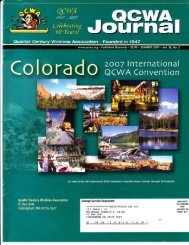
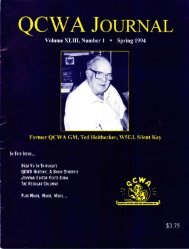
![11{J hI EfifSIt]E I]E - Quarter Century Wireless Association](https://img.yumpu.com/11816560/1/190x245/11j-hi-efifsite-ie-quarter-century-wireless-association.jpg?quality=85)
